Case Study Analysis: Procter & Gamble's Marketing and Distribution
VerifiedAdded on 2022/09/13
|7
|1442
|16
Case Study
AI Summary
This case study analyzes Procter & Gamble's (P&G) marketing and distribution strategies, focusing on challenges like shelf space limitations, new distribution channels (mobile and internet), and transportation issues. The analysis explores P&G's approach to expanding its market presence, including the acquisition of Gillette, and its adoption of direct-to-consumer channels. The study examines channel conflicts arising from P&G's arrangements with Amazon and discusses the company's use of compressed natural gas trucks for environmental sustainability. The case addresses key marketing issues, provides a personal analysis of the situation, and answers questions regarding direct channels, channel conflicts, and transportation methods, concluding with an overview of P&G's efforts to maintain its position in the consumer goods market and expand into emerging markets. The case study also highlights P&G's innovation in distribution and its commitment to environmental responsibility.
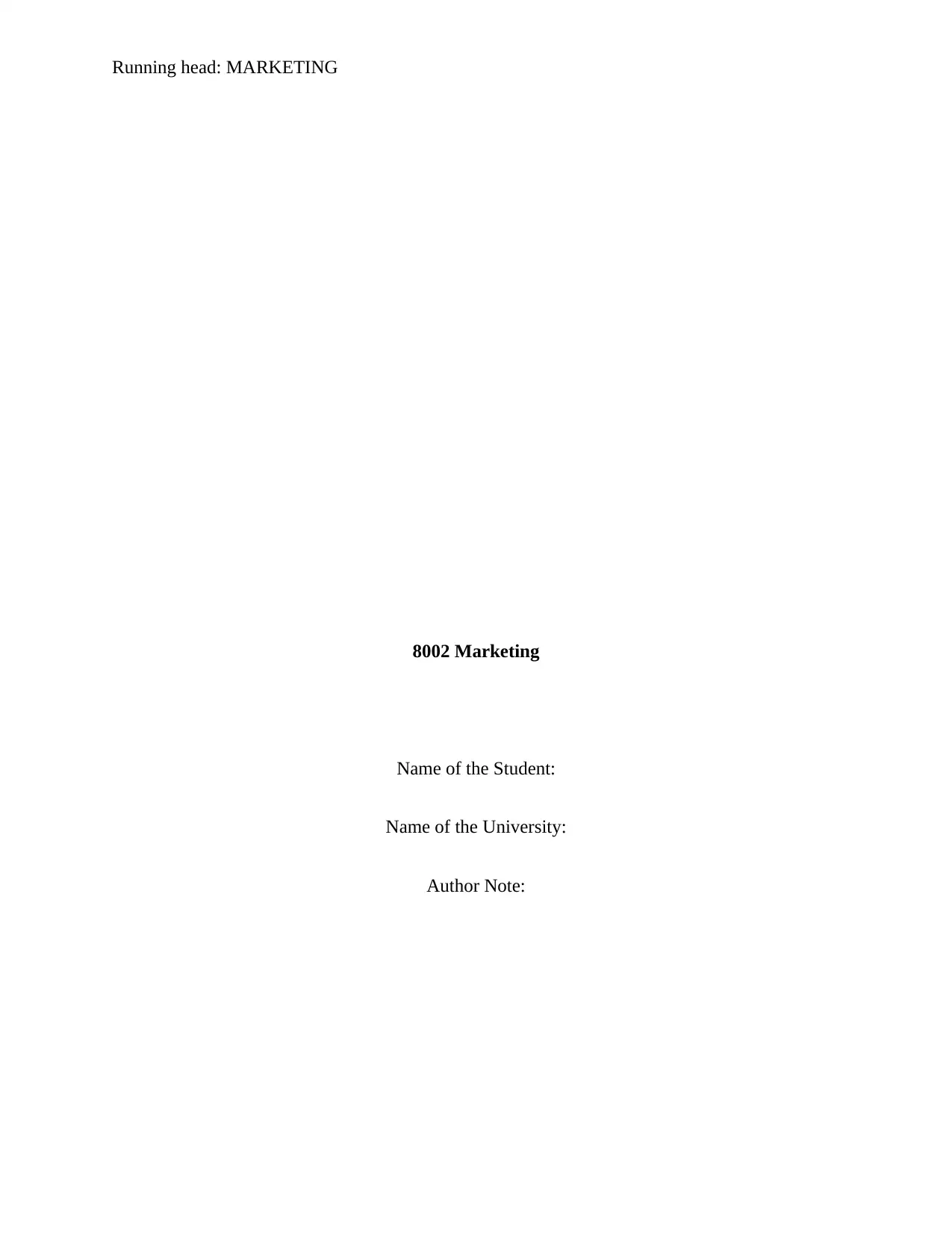
Running head: MARKETING
8002 Marketing
Name of the Student:
Name of the University:
Author Note:
8002 Marketing
Name of the Student:
Name of the University:
Author Note:
Paraphrase This Document
Need a fresh take? Get an instant paraphrase of this document with our AI Paraphraser
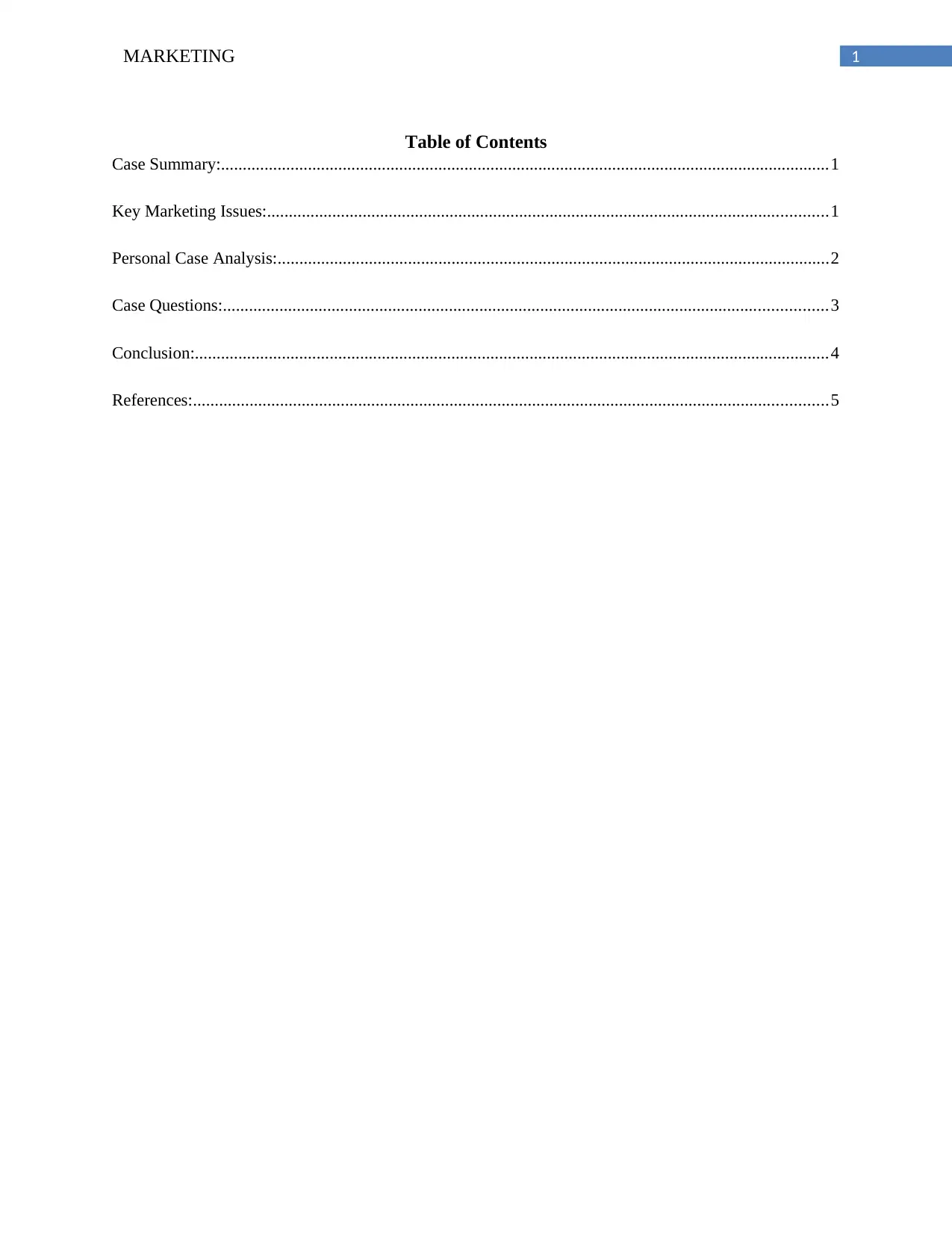
MARKETING 1
Table of Contents
Case Summary:............................................................................................................................................1
Key Marketing Issues:.................................................................................................................................1
Personal Case Analysis:...............................................................................................................................2
Case Questions:...........................................................................................................................................3
Conclusion:..................................................................................................................................................4
References:..................................................................................................................................................5
Table of Contents
Case Summary:............................................................................................................................................1
Key Marketing Issues:.................................................................................................................................1
Personal Case Analysis:...............................................................................................................................2
Case Questions:...........................................................................................................................................3
Conclusion:..................................................................................................................................................4
References:..................................................................................................................................................5
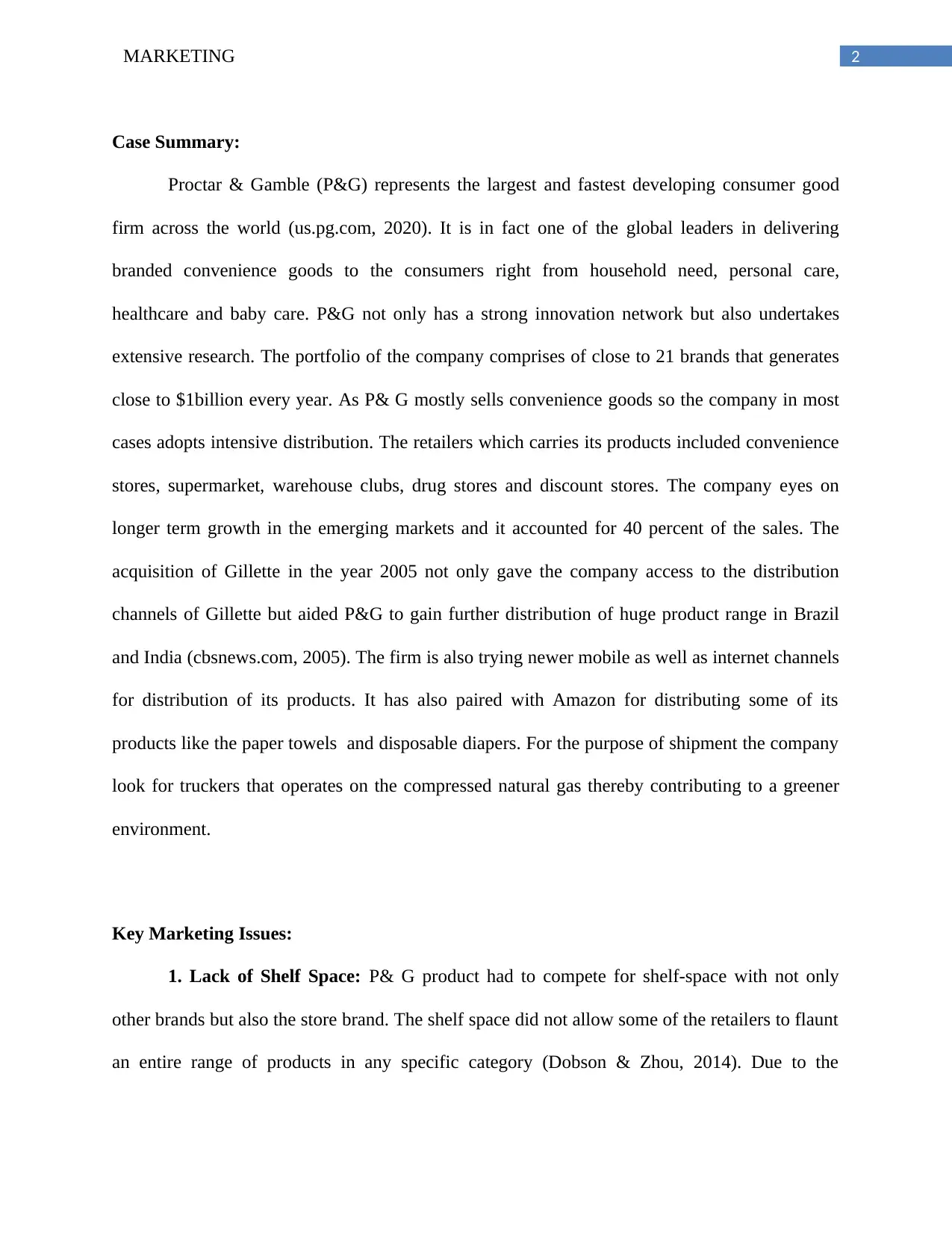
2MARKETING
Case Summary:
Proctar & Gamble (P&G) represents the largest and fastest developing consumer good
firm across the world (us.pg.com, 2020). It is in fact one of the global leaders in delivering
branded convenience goods to the consumers right from household need, personal care,
healthcare and baby care. P&G not only has a strong innovation network but also undertakes
extensive research. The portfolio of the company comprises of close to 21 brands that generates
close to $1billion every year. As P& G mostly sells convenience goods so the company in most
cases adopts intensive distribution. The retailers which carries its products included convenience
stores, supermarket, warehouse clubs, drug stores and discount stores. The company eyes on
longer term growth in the emerging markets and it accounted for 40 percent of the sales. The
acquisition of Gillette in the year 2005 not only gave the company access to the distribution
channels of Gillette but aided P&G to gain further distribution of huge product range in Brazil
and India (cbsnews.com, 2005). The firm is also trying newer mobile as well as internet channels
for distribution of its products. It has also paired with Amazon for distributing some of its
products like the paper towels and disposable diapers. For the purpose of shipment the company
look for truckers that operates on the compressed natural gas thereby contributing to a greener
environment.
Key Marketing Issues:
1. Lack of Shelf Space: P& G product had to compete for shelf-space with not only
other brands but also the store brand. The shelf space did not allow some of the retailers to flaunt
an entire range of products in any specific category (Dobson & Zhou, 2014). Due to the
Case Summary:
Proctar & Gamble (P&G) represents the largest and fastest developing consumer good
firm across the world (us.pg.com, 2020). It is in fact one of the global leaders in delivering
branded convenience goods to the consumers right from household need, personal care,
healthcare and baby care. P&G not only has a strong innovation network but also undertakes
extensive research. The portfolio of the company comprises of close to 21 brands that generates
close to $1billion every year. As P& G mostly sells convenience goods so the company in most
cases adopts intensive distribution. The retailers which carries its products included convenience
stores, supermarket, warehouse clubs, drug stores and discount stores. The company eyes on
longer term growth in the emerging markets and it accounted for 40 percent of the sales. The
acquisition of Gillette in the year 2005 not only gave the company access to the distribution
channels of Gillette but aided P&G to gain further distribution of huge product range in Brazil
and India (cbsnews.com, 2005). The firm is also trying newer mobile as well as internet channels
for distribution of its products. It has also paired with Amazon for distributing some of its
products like the paper towels and disposable diapers. For the purpose of shipment the company
look for truckers that operates on the compressed natural gas thereby contributing to a greener
environment.
Key Marketing Issues:
1. Lack of Shelf Space: P& G product had to compete for shelf-space with not only
other brands but also the store brand. The shelf space did not allow some of the retailers to flaunt
an entire range of products in any specific category (Dobson & Zhou, 2014). Due to the
⊘ This is a preview!⊘
Do you want full access?
Subscribe today to unlock all pages.

Trusted by 1+ million students worldwide
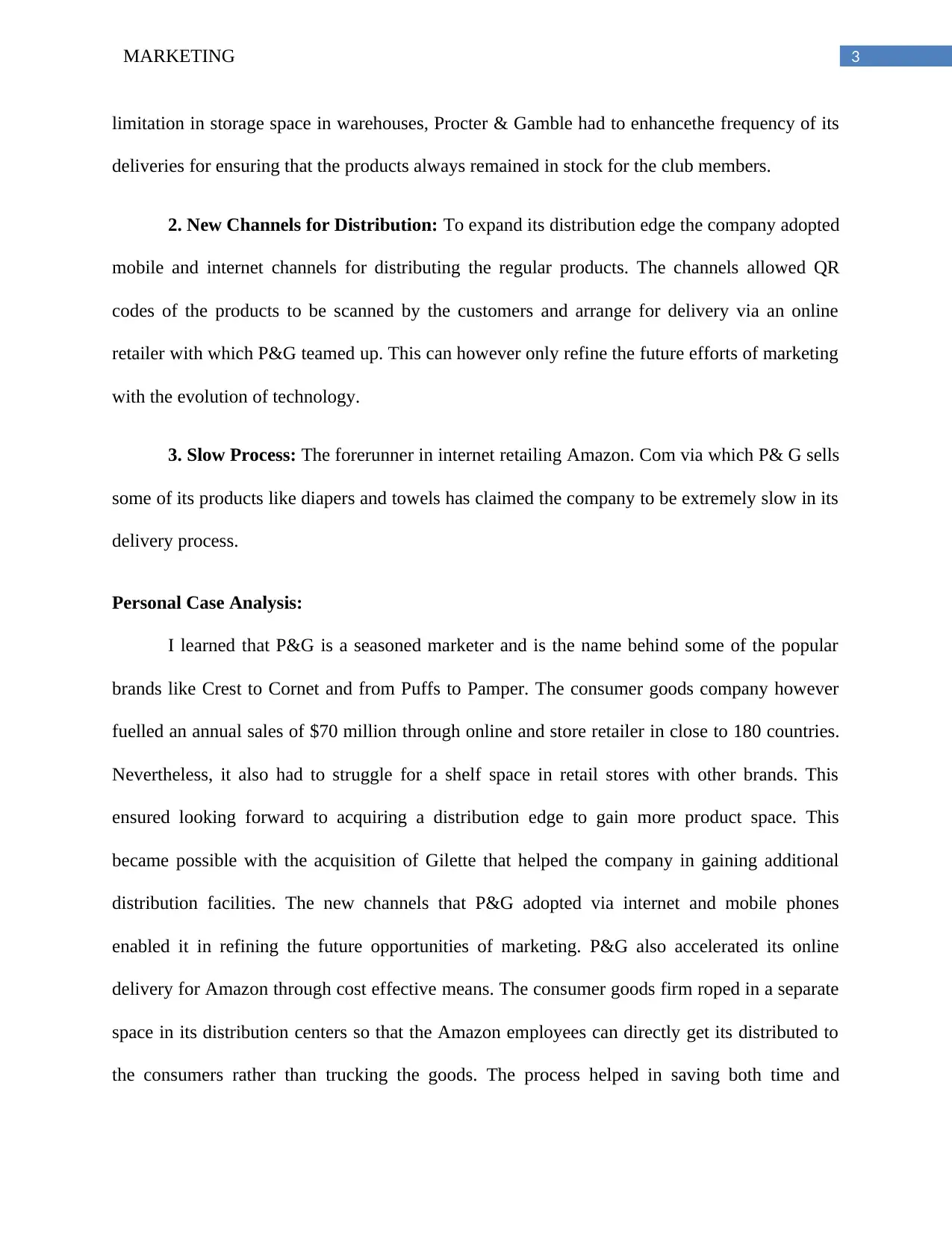
3MARKETING
limitation in storage space in warehouses, Procter & Gamble had to enhancethe frequency of its
deliveries for ensuring that the products always remained in stock for the club members.
2. New Channels for Distribution: To expand its distribution edge the company adopted
mobile and internet channels for distributing the regular products. The channels allowed QR
codes of the products to be scanned by the customers and arrange for delivery via an online
retailer with which P&G teamed up. This can however only refine the future efforts of marketing
with the evolution of technology.
3. Slow Process: The forerunner in internet retailing Amazon. Com via which P& G sells
some of its products like diapers and towels has claimed the company to be extremely slow in its
delivery process.
Personal Case Analysis:
I learned that P&G is a seasoned marketer and is the name behind some of the popular
brands like Crest to Cornet and from Puffs to Pamper. The consumer goods company however
fuelled an annual sales of $70 million through online and store retailer in close to 180 countries.
Nevertheless, it also had to struggle for a shelf space in retail stores with other brands. This
ensured looking forward to acquiring a distribution edge to gain more product space. This
became possible with the acquisition of Gilette that helped the company in gaining additional
distribution facilities. The new channels that P&G adopted via internet and mobile phones
enabled it in refining the future opportunities of marketing. P&G also accelerated its online
delivery for Amazon through cost effective means. The consumer goods firm roped in a separate
space in its distribution centers so that the Amazon employees can directly get its distributed to
the consumers rather than trucking the goods. The process helped in saving both time and
limitation in storage space in warehouses, Procter & Gamble had to enhancethe frequency of its
deliveries for ensuring that the products always remained in stock for the club members.
2. New Channels for Distribution: To expand its distribution edge the company adopted
mobile and internet channels for distributing the regular products. The channels allowed QR
codes of the products to be scanned by the customers and arrange for delivery via an online
retailer with which P&G teamed up. This can however only refine the future efforts of marketing
with the evolution of technology.
3. Slow Process: The forerunner in internet retailing Amazon. Com via which P& G sells
some of its products like diapers and towels has claimed the company to be extremely slow in its
delivery process.
Personal Case Analysis:
I learned that P&G is a seasoned marketer and is the name behind some of the popular
brands like Crest to Cornet and from Puffs to Pamper. The consumer goods company however
fuelled an annual sales of $70 million through online and store retailer in close to 180 countries.
Nevertheless, it also had to struggle for a shelf space in retail stores with other brands. This
ensured looking forward to acquiring a distribution edge to gain more product space. This
became possible with the acquisition of Gilette that helped the company in gaining additional
distribution facilities. The new channels that P&G adopted via internet and mobile phones
enabled it in refining the future opportunities of marketing. P&G also accelerated its online
delivery for Amazon through cost effective means. The consumer goods firm roped in a separate
space in its distribution centers so that the Amazon employees can directly get its distributed to
the consumers rather than trucking the goods. The process helped in saving both time and
Paraphrase This Document
Need a fresh take? Get an instant paraphrase of this document with our AI Paraphraser
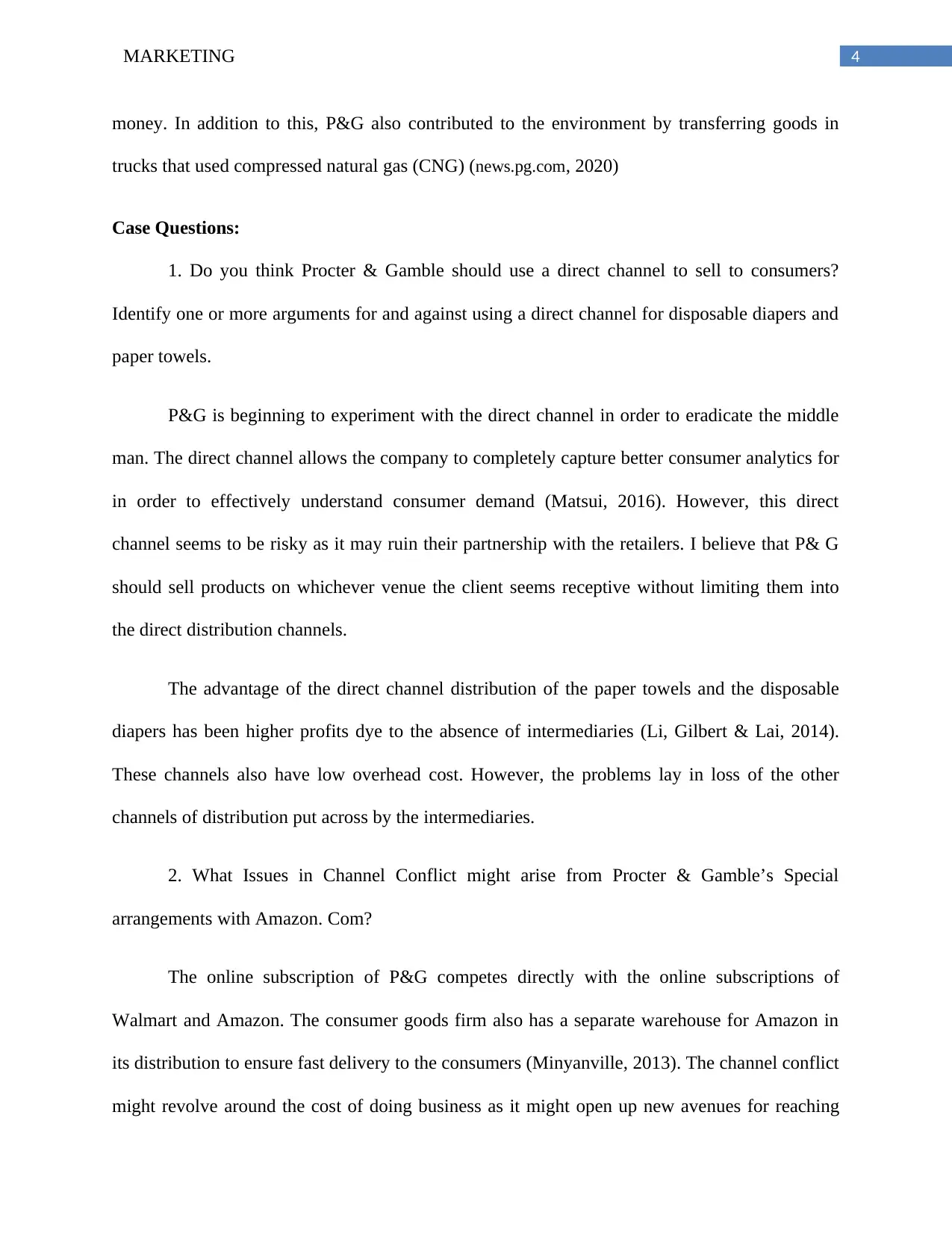
4MARKETING
money. In addition to this, P&G also contributed to the environment by transferring goods in
trucks that used compressed natural gas (CNG) (news.pg.com, 2020)
Case Questions:
1. Do you think Procter & Gamble should use a direct channel to sell to consumers?
Identify one or more arguments for and against using a direct channel for disposable diapers and
paper towels.
P&G is beginning to experiment with the direct channel in order to eradicate the middle
man. The direct channel allows the company to completely capture better consumer analytics for
in order to effectively understand consumer demand (Matsui, 2016). However, this direct
channel seems to be risky as it may ruin their partnership with the retailers. I believe that P& G
should sell products on whichever venue the client seems receptive without limiting them into
the direct distribution channels.
The advantage of the direct channel distribution of the paper towels and the disposable
diapers has been higher profits dye to the absence of intermediaries (Li, Gilbert & Lai, 2014).
These channels also have low overhead cost. However, the problems lay in loss of the other
channels of distribution put across by the intermediaries.
2. What Issues in Channel Conflict might arise from Procter & Gamble’s Special
arrangements with Amazon. Com?
The online subscription of P&G competes directly with the online subscriptions of
Walmart and Amazon. The consumer goods firm also has a separate warehouse for Amazon in
its distribution to ensure fast delivery to the consumers (Minyanville, 2013). The channel conflict
might revolve around the cost of doing business as it might open up new avenues for reaching
money. In addition to this, P&G also contributed to the environment by transferring goods in
trucks that used compressed natural gas (CNG) (news.pg.com, 2020)
Case Questions:
1. Do you think Procter & Gamble should use a direct channel to sell to consumers?
Identify one or more arguments for and against using a direct channel for disposable diapers and
paper towels.
P&G is beginning to experiment with the direct channel in order to eradicate the middle
man. The direct channel allows the company to completely capture better consumer analytics for
in order to effectively understand consumer demand (Matsui, 2016). However, this direct
channel seems to be risky as it may ruin their partnership with the retailers. I believe that P& G
should sell products on whichever venue the client seems receptive without limiting them into
the direct distribution channels.
The advantage of the direct channel distribution of the paper towels and the disposable
diapers has been higher profits dye to the absence of intermediaries (Li, Gilbert & Lai, 2014).
These channels also have low overhead cost. However, the problems lay in loss of the other
channels of distribution put across by the intermediaries.
2. What Issues in Channel Conflict might arise from Procter & Gamble’s Special
arrangements with Amazon. Com?
The online subscription of P&G competes directly with the online subscriptions of
Walmart and Amazon. The consumer goods firm also has a separate warehouse for Amazon in
its distribution to ensure fast delivery to the consumers (Minyanville, 2013). The channel conflict
might revolve around the cost of doing business as it might open up new avenues for reaching
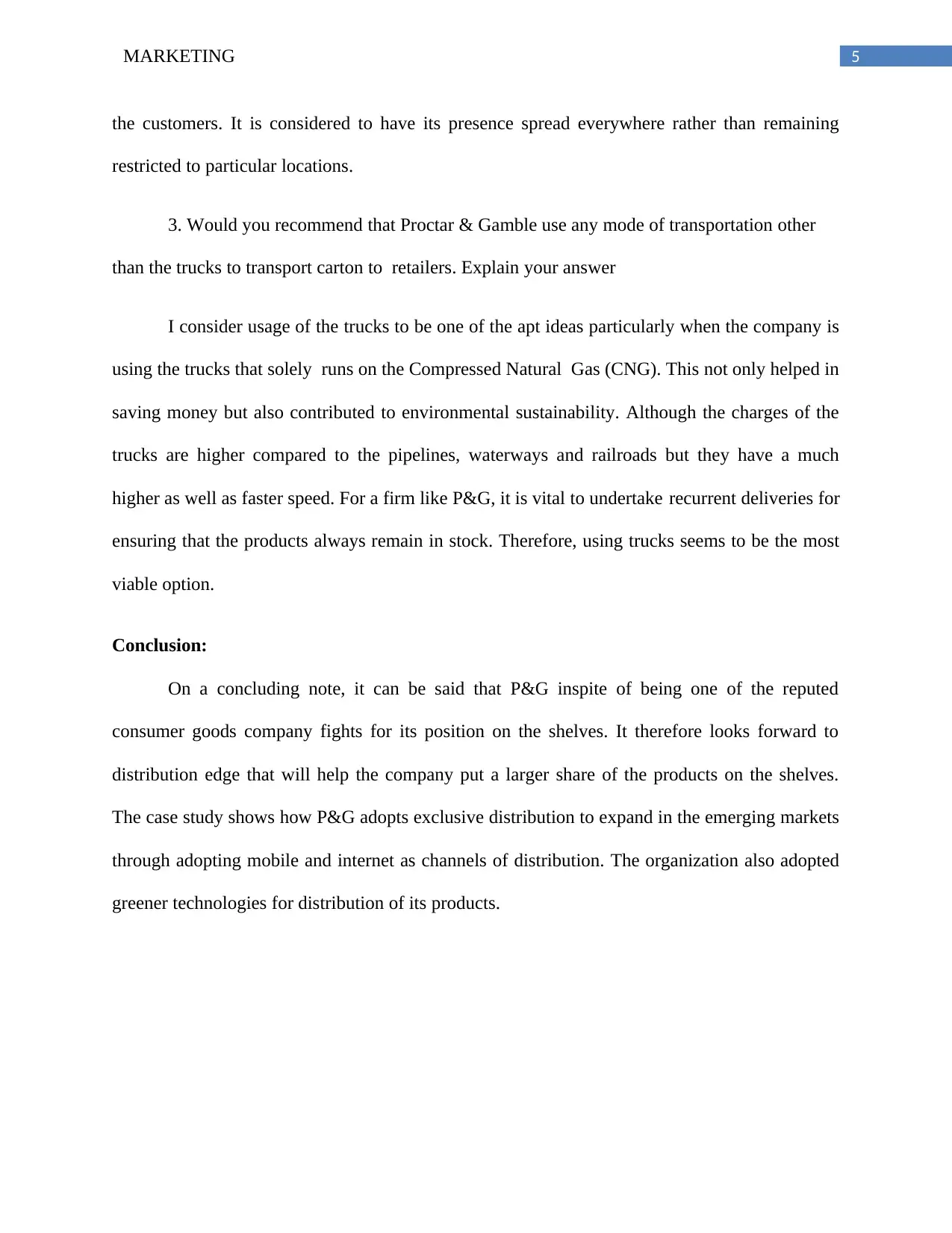
5MARKETING
the customers. It is considered to have its presence spread everywhere rather than remaining
restricted to particular locations.
3. Would you recommend that Proctar & Gamble use any mode of transportation other
than the trucks to transport carton to retailers. Explain your answer
I consider usage of the trucks to be one of the apt ideas particularly when the company is
using the trucks that solely runs on the Compressed Natural Gas (CNG). This not only helped in
saving money but also contributed to environmental sustainability. Although the charges of the
trucks are higher compared to the pipelines, waterways and railroads but they have a much
higher as well as faster speed. For a firm like P&G, it is vital to undertake recurrent deliveries for
ensuring that the products always remain in stock. Therefore, using trucks seems to be the most
viable option.
Conclusion:
On a concluding note, it can be said that P&G inspite of being one of the reputed
consumer goods company fights for its position on the shelves. It therefore looks forward to
distribution edge that will help the company put a larger share of the products on the shelves.
The case study shows how P&G adopts exclusive distribution to expand in the emerging markets
through adopting mobile and internet as channels of distribution. The organization also adopted
greener technologies for distribution of its products.
the customers. It is considered to have its presence spread everywhere rather than remaining
restricted to particular locations.
3. Would you recommend that Proctar & Gamble use any mode of transportation other
than the trucks to transport carton to retailers. Explain your answer
I consider usage of the trucks to be one of the apt ideas particularly when the company is
using the trucks that solely runs on the Compressed Natural Gas (CNG). This not only helped in
saving money but also contributed to environmental sustainability. Although the charges of the
trucks are higher compared to the pipelines, waterways and railroads but they have a much
higher as well as faster speed. For a firm like P&G, it is vital to undertake recurrent deliveries for
ensuring that the products always remain in stock. Therefore, using trucks seems to be the most
viable option.
Conclusion:
On a concluding note, it can be said that P&G inspite of being one of the reputed
consumer goods company fights for its position on the shelves. It therefore looks forward to
distribution edge that will help the company put a larger share of the products on the shelves.
The case study shows how P&G adopts exclusive distribution to expand in the emerging markets
through adopting mobile and internet as channels of distribution. The organization also adopted
greener technologies for distribution of its products.
⊘ This is a preview!⊘
Do you want full access?
Subscribe today to unlock all pages.

Trusted by 1+ million students worldwide
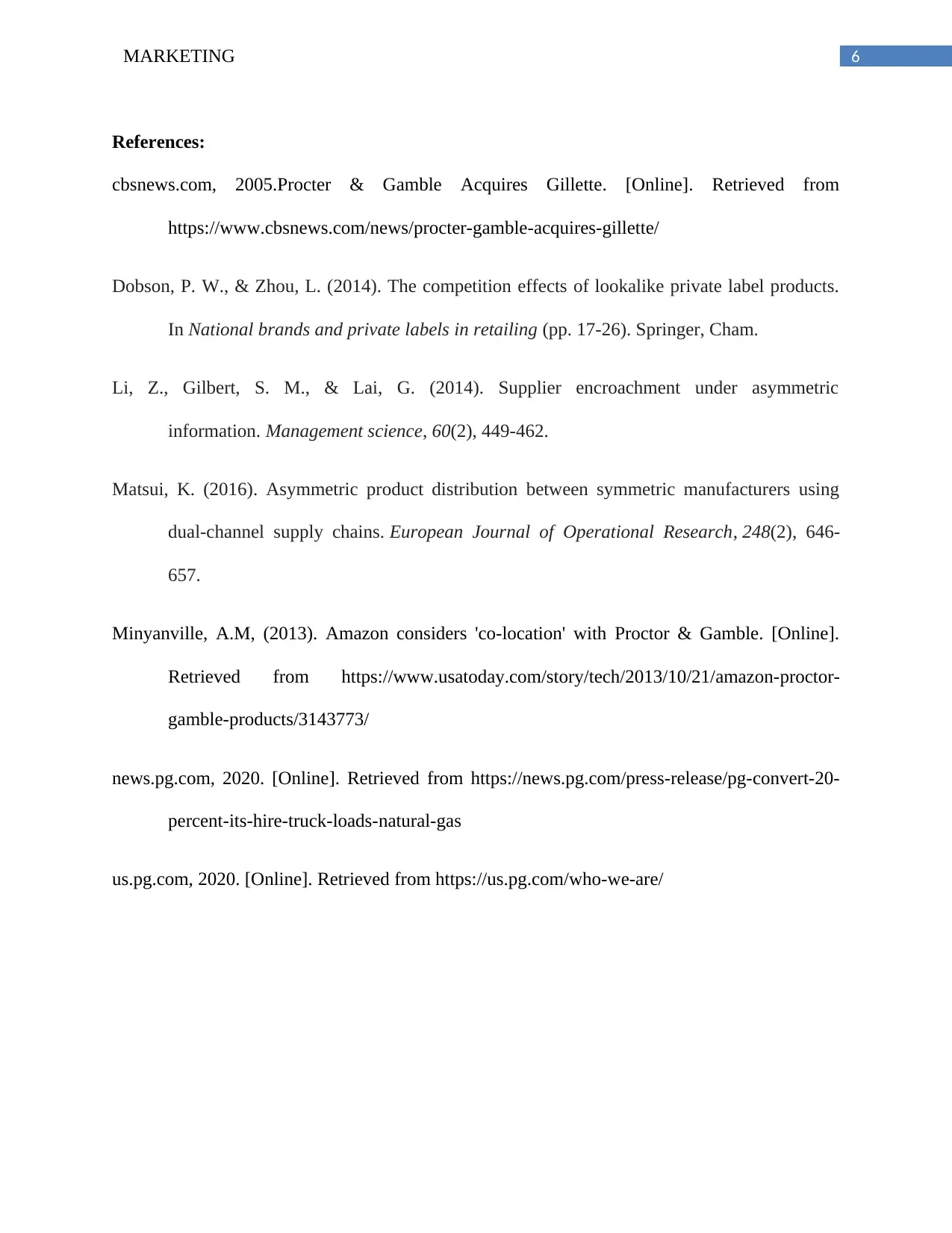
6MARKETING
References:
cbsnews.com, 2005.Procter & Gamble Acquires Gillette. [Online]. Retrieved from
https://www.cbsnews.com/news/procter-gamble-acquires-gillette/
Dobson, P. W., & Zhou, L. (2014). The competition effects of lookalike private label products.
In National brands and private labels in retailing (pp. 17-26). Springer, Cham.
Li, Z., Gilbert, S. M., & Lai, G. (2014). Supplier encroachment under asymmetric
information. Management science, 60(2), 449-462.
Matsui, K. (2016). Asymmetric product distribution between symmetric manufacturers using
dual-channel supply chains. European Journal of Operational Research, 248(2), 646-
657.
Minyanville, A.M, (2013). Amazon considers 'co-location' with Proctor & Gamble. [Online].
Retrieved from https://www.usatoday.com/story/tech/2013/10/21/amazon-proctor-
gamble-products/3143773/
news.pg.com, 2020. [Online]. Retrieved from https://news.pg.com/press-release/pg-convert-20-
percent-its-hire-truck-loads-natural-gas
us.pg.com, 2020. [Online]. Retrieved from https://us.pg.com/who-we-are/
References:
cbsnews.com, 2005.Procter & Gamble Acquires Gillette. [Online]. Retrieved from
https://www.cbsnews.com/news/procter-gamble-acquires-gillette/
Dobson, P. W., & Zhou, L. (2014). The competition effects of lookalike private label products.
In National brands and private labels in retailing (pp. 17-26). Springer, Cham.
Li, Z., Gilbert, S. M., & Lai, G. (2014). Supplier encroachment under asymmetric
information. Management science, 60(2), 449-462.
Matsui, K. (2016). Asymmetric product distribution between symmetric manufacturers using
dual-channel supply chains. European Journal of Operational Research, 248(2), 646-
657.
Minyanville, A.M, (2013). Amazon considers 'co-location' with Proctor & Gamble. [Online].
Retrieved from https://www.usatoday.com/story/tech/2013/10/21/amazon-proctor-
gamble-products/3143773/
news.pg.com, 2020. [Online]. Retrieved from https://news.pg.com/press-release/pg-convert-20-
percent-its-hire-truck-loads-natural-gas
us.pg.com, 2020. [Online]. Retrieved from https://us.pg.com/who-we-are/
1 out of 7
Related Documents
Your All-in-One AI-Powered Toolkit for Academic Success.
+13062052269
info@desklib.com
Available 24*7 on WhatsApp / Email
![[object Object]](/_next/static/media/star-bottom.7253800d.svg)
Unlock your academic potential
Copyright © 2020–2025 A2Z Services. All Rights Reserved. Developed and managed by ZUCOL.




